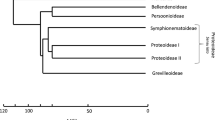Abstract
It is widely acknowledged that the evolution of pollen grains has followed three main trends.
Access this chapter
Tax calculation will be finalised at checkout
Purchases are for personal use only
Preview
Unable to display preview. Download preview PDF.
Similar content being viewed by others
References
Alexander, M.P. 1969. Differential staining of aborted and non-aborted pollen. Stain Technology 44 (3): 117 – 122.
Brewbaker, J.L. 1967. The distribution and phylogenetic significance of binucleate and trinucleate pollen grains in the Angiosperms. Am. J. Bot. 54 (9): 1069 – 1083.
Dajoz, I. 1990. Polymorphism chez le pollen et la fleur de Viola diversifolia(Gingins) Becker. Bull. soc. Bot. Fr. (1137), Actual, bot. (2): 148 – 150.
Dajoz, I. 1990. Polymorphism chez le pollen et la fleur de Viola diversifolia(Gingins) Becker. Bull. soc. Bot. Fr. (1137), Actual, bot. (2): 148 – 150.
Galen, C.; Shykoff, J.A. & Plowright, R.C. 1986. Consequences of stigma receptivity schedules for sexual selection in higher plants. Am. Nat. 127(4);462–476.
Gouyon, P.H.; Till-Bottraud, I; Venable, L & Dajoz, I. in prep.
Hoekstra, F.A. 1983. Physiological evolution in Angiosperm pollen: possible role of pollen vigor, in: Pollen: Biology and implications for plant breeding. D.L Mulcahy & E. Ottaviano, eds., Elsevier Science Publishing Co., New York:29–33.
Hoekstra, F.A. & Bruinsma, J. 1975. Respiration and vitality of binucleate and trinucleate pollen. Physiol. Rant. 34: 221 – 225.
Mulcahy, D.L 1974. Correlation between speed of pollen tube growth and seedling height in Zea mays L Nature 249: 491 – 492.
Mulcahy, D.L & Mulcahy, G. B. 1975. The influence of gametophytic competition on sporophytic quality in Dianthus chinesis. Theor. Appl. Genet. 46: 277 – 280.
Mulcahy, G.B. & Mulcahy, D.L 1983. A comparison of pollen tube growth in bi-and tri-nucleate pollen, in: Pollen: Biology and implications for plant breeding. D.L Mulcahy & E. Ottaviano, eds. Elsevier Science Publishing, Co.,New York: 35 – 41.
Mulcahy, D.L & Mulcahy, G.B. 1987. The effects of pollen competition.American Scientist 75: 44 – 50.
Ottaviano, E.; Sari-Gorla, M. & Mulcahy, D.L 1980. Pollen tube growth rates in Zea mays: implications for the genetic improvement of crops. Science 210: 437 – 438.
Ottaviano, E.; Sari-Gorla, M. & Villa, M. 1988b. Pollen competitive ability in maize: within population variability and response to selection. Theor. Appl. Genet. 76: 601 – 608.
Sarr, A.; Sandmeier, M. & Pernes, J. 1988. Gametophytic competition in pearl millet, Pennisetum typhoides (Stapf et Hubb.). Genome 30: 924 – 929.
Shivanna, K.R. & Heslop-Harrison, J. 1981. Membrane state and pollen viability. Ann. Bot. 47: 759 – 770.
Snow, A.A. & Mazer, S.J. 1988. Gametophytic selection in Raphanusraphanistrum: a test for heritable variation in pollen competitive ability. Evolution 42 (5): 1065 – 1075.
Van Campo, M. 1976. Patterns of pollen morphological variation within taxa.in: The evolutionary significance of the exine. Eds., I.K. Ferguson & J.Muller. Academic Press, Inc., New York:163–183.
Walker, J.W. & Doyle, J.A. 1975. The bases of Angiosperm phytogeny: palynology. Ann. Mo. Bot. Gard. 62: 664 – 725.
Williams, E.G. & Rouse, J.L. 1990. Relationships of pollen size, pistil length and pollen tube growth rates in Fftododendron and their influence on hybridization. Sex. Plant Reprod. 3: 7 – 17.
Editor information
Editors and Affiliations
Rights and permissions
Copyright information
© 1992 Springer-Verlag New York, Inc.
About this paper
Cite this paper
Dajoz, I., Till-Bottraud, I., Gouyon, PH. (1992). Evolution of Pollen Morphology: The Hare and Tortoise Game. In: Ottaviano, E., Gorla, M.S., Mulcahy, D.L., Mulcahy, G.B. (eds) Angiosperm Pollen and Ovules. Springer, New York, NY. https://doi.org/10.1007/978-1-4612-2958-2_68
Download citation
DOI: https://doi.org/10.1007/978-1-4612-2958-2_68
Publisher Name: Springer, New York, NY
Print ISBN: 978-1-4612-7733-0
Online ISBN: 978-1-4612-2958-2
eBook Packages: Springer Book Archive




